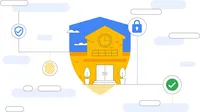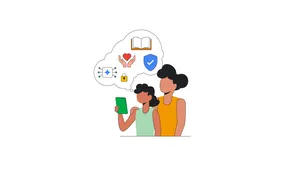New updates to ensure safer learning at school and at home

The Google for Education team continues to build education services with highly sophisticated privacy technology at their core in partnership with policymakers, data-privacy regulators, third-party groups, and education institutions worldwide. Today, we’re sharing updates for our work globally, to help students, parents, and educators keep their data secure and private, and make sure they are in control when using our services. This includes new features in Google Workspace for Education and Chromebooks, such as data processor mode for ChromeOS and the new Service Data Addendum for Google Workspace for Education.
New controls for administrators
We’ve added more features in Google Workspace for Education to create a safer learning experience. Now available, context-aware access improvements will help admins control who is accessing which apps in an organization, and when. AI-powered spam view in Google Drive makes it easier to separate and review your files, decide what you might view as spam and stay safe from potentially unwanted or abusive content. And coming soon, app badges will help you make more informed decisions about third-party app access for your users.
On Chromebooks, admins now have more data controls in Google Admin console to prevent access to and from websites. Users will also soon be able to toggle the camera and mic off in their own settings. Our app developer partners like GoGuardian provide additional controls within Workspace and ChromeOS, enabling admins and schools to individualize privacy settings for their organization’s needs. To make the most of all of these tools, we recently authored a K-12 Cybersecurity Guidebook to help admins better protect schools from threats.
For schools that want even more control over how their data is processed, we will begin to offer data processor mode for managed ChromeOS devices. This gives customers the option to shift Google’s primary role from that of a data controller to a data processor. Available today in the Netherlands, following our partnership with the Dutch government and education sector, we plan to make data processor mode available to more European countries from 2024 onwards.
Alongside this new mode, we are also launching a new set of tools to help customers more easily fulfill their privacy obligations (e.g. Data Subject Access Requests), and achieve greater insight into, and control over, the data processed by Google.
Admins will find this mode and additional controls in the compliance center in Google Admin console. It’s up to customers to decide whether they prefer Google to act primarily as a data controller or data processor, depending upon what works best for them.
Lastly, and in line with our commitment noted in this blog post, this week we began rolling out our new Service Data Addendum (SDA) globally for eligible customers that want more control over their Service Data when they use Google Workspace for Education. The SDA includes new contractual privacy commitments for Service Data that align with the commitments we already offer for Customer Data. Learn more on our support page.
The distinction between school and personal accounts
Learning is at the core of what Google does. And as students learn and grow, we provide tools to keep students safer online, both in school and at home. School-issued and personal accounts are completely separate; in fact, for Google Workspace for Education accounts, all user data is owned and managed by the organization, not Google. All Google does is provide the tech to help keep learning going.
Safer digital learning for school
When learners are at school, they use a school-issued account to access Google for Education, an education technology solution that integrates Google Workspace for Education core services — that are ad-free — like Google Classroom, Docs, Slides, and Gmail. They also use devices like Chromebooks, designed to provide safer digital learning environments, all managed at scale by education administrators, and compliant with local and country-wide regulations. While at school, education administrators are in charge: They can use robust tools with the highest restriction of privacy to help control what students see and do online, including blocking inappropriate content.
An important part of learning is the school community, including parents and guardians. While administrators manage access to Google Workspace for Education Services, schools also obtain parents' consent before providing access to additional Google services like Search, Maps and Translate. If required by applicable law, schools can also obtain consent to any third-party services accessed with Google Workspace for Education accounts. Educators can share resources so parents and guardians can learn more about what tools their children are using for school with our Guardian’s Guides, and find more about our commitment to privacy and security in our Guardian’s Guide to Safer Learning.
Safer digital learning for home
For learning at home, Google provides tools to parents and guardians, to manage their child’s personal account – separate from their school account. This includes controls for their child’s personal Google account, like Family Link, which helps parents manage children's devices and online activity, with features like app approval and screen time limits. Other learning tools like YouTube Kids, KidsSpace and Teacher Approved Apps in the Play Store let kids and teens explore the web at home on their personal accounts and devices with age appropriate content.
And of course, learners need to grow into smart online citizens. That’s why we build curricula like Be Internet Awesome that teaches kids the skills they need to stay safe and be responsible online, along with resources and features for digital wellbeing. We also partner with organizations like CommonSense Media, ConnectSafely, and FOSI to help inform and guide families in protecting students online.
Parents and guardians can find resources on what tools to use for learning at home, along with FAQs, on our Families website and the Google Safety Center.






